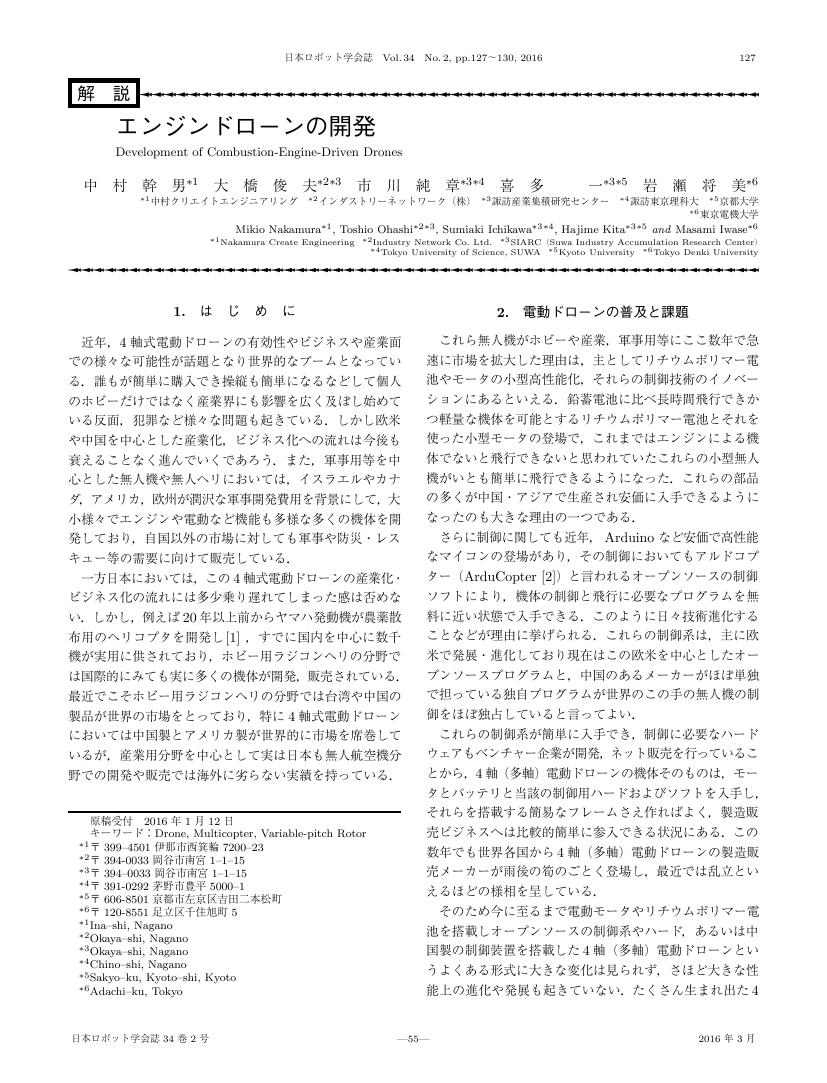11 0 0 0 OA 唯脳論
- 著者
- 養老 孟司
- 出版者
- The Robotics Society of Japan
- 雑誌
- 日本ロボット学会誌 (ISSN:02891824)
- 巻号頁・発行日
- vol.7, no.5, pp.528-534, 1989-10-15 (Released:2010-08-10)
11 0 0 0 OA 把持のロバスト性解析に基づくケージング拘束の定量的評価
- 著者
- 牧原 昂志 槇田 諭
- 出版者
- 一般社団法人 日本ロボット学会
- 雑誌
- 日本ロボット学会誌 (ISSN:02891824)
- 巻号頁・発行日
- vol.38, no.5, pp.496-501, 2020 (Released:2020-06-17)
- 参考文献数
- 12
This paper presents a novel measurement method for caging quality based on static analysis of robotic grasping and manipulation. Caging is a geometrical constraint of objects in which those captured by surrounding robots are restricted to move in the bounded space. The object constraint with some margin is a promising tool to allow uncertainties appearing in object perception and robot control. Because of limitation of robot configuration, complete caging that the object never escape from is, however, not accomplished sometimes, and the target object is partially caged. As for such partial caging, the quality of geometrical constraint has not been sufficiently evaluated. In this paper, we propose an evaluation index of the quality based on the robustness of grasping and manipulation in order to deal with both caging and mechanical constraint simultaneously. Some numerical results are presented to validate our proposed procedure of evaluation.
11 0 0 0 OA 拝啓,同志 ロボット研究者・技術者諸君!
- 著者
- 江尻 正員
- 出版者
- 一般社団法人 日本ロボット学会
- 雑誌
- 日本ロボット学会誌 (ISSN:02891824)
- 巻号頁・発行日
- vol.33, no.4, pp.247-250, 2015 (Released:2015-06-15)
- 参考文献数
- 6
10 0 0 0 OA 折り紙を折るロボット
- 著者
- 横小路 泰義
- 出版者
- 一般社団法人 日本ロボット学会
- 雑誌
- 日本ロボット学会誌 (ISSN:02891824)
- 巻号頁・発行日
- vol.31, no.4, pp.334-340, 2013 (Released:2013-06-15)
- 参考文献数
- 12
- 被引用文献数
- 1
10 0 0 0 OA 粘菌の経路探索における最適化
- 著者
- 小林 亮
- 出版者
- 一般社団法人 日本ロボット学会
- 雑誌
- 日本ロボット学会誌 (ISSN:02891824)
- 巻号頁・発行日
- vol.32, no.6, pp.530-535, 2014 (Released:2014-08-15)
- 参考文献数
- 10
10 0 0 0 OA How to Make a Conscious Robot
- 著者
- Takashi Maeno
- 出版者
- The Robotics Society of Japan
- 雑誌
- Journal of the Robotics Society of Japan (ISSN:02891824)
- 巻号頁・発行日
- vol.23, no.1, pp.51-62, 2005-01-15 (Released:2010-08-25)
- 参考文献数
- 32
- 被引用文献数
- 3 10 13
A fundamental idea for constructing a conscious robot is presented. First, hypotheses of the human mind are presented. The following ideas are shown: (1) The unconscious system is a recurrent network system made of various distributed subsystems. (2) Information of the mind such as intellect, feelings and willpower, is presumably processed in the unconscious system instead of the conscious system. (3) The conscious system just monitors, experiences afterward, models and memorizes the results of the unconscious system. (4) Realistic experiences of quality that the conscious system feels by itself are just illusions that are defined in the brain. Then an algorithm of a robot mind is constructed based on the hypotheses mentioned above. It is shown that a conscious mind of robots can be made using the proposed algorithm. Finally, purposes and issues of the robots with a mind are also discussed.
10 0 0 0 OA 鼓動
- 著者
- 瀬名 秀明
- 出版者
- 一般社団法人 日本ロボット学会
- 雑誌
- 日本ロボット学会誌 (ISSN:02891824)
- 巻号頁・発行日
- vol.38, no.1, pp.78-94, 2020 (Released:2020-01-16)
10 0 0 0 OA 呪われた孤児としての現存せざるロボット
- 著者
- 松浦 和也
- 出版者
- 一般社団法人 日本ロボット学会
- 雑誌
- 日本ロボット学会誌 (ISSN:02891824)
- 巻号頁・発行日
- vol.38, no.9, pp.857-859, 2020 (Released:2020-11-21)
- 参考文献数
- 15
Much of the discussion on robot and AI ethics seems to share images and representation of robots and autonomous machine, which derive from literatures including SCI FI novels. This article aims to reveal the implication and hidden ethical problems in the concept of robots in literatures by reviewing the etymological origin of terms concerning robots, namely, mechanism, android, and automaton. The usage of the last and its role in Greek myth shows that robots as character in dramas unavoidably have tragic role to make human-being misfortune. This can mean that robots in literatures, and the ethical discussion based on representation of robots appearing in literatures, have ethical problems in nature. Therefore, if we want to establish practical and realistic ethics of robotics, we need to intentionally ignore the representation of robots in literatures, and the rules of robots such as the three laws of robotics in Asimov's novels.
10 0 0 0 OA 対話ロボットの反応時間と反応遅延時における間投詞の効果
- 著者
- 志和 敏之 神田 崇行 今井 倫太 石黒 浩 萩田 紀博 安西 祐一郎
- 出版者
- 一般社団法人 日本ロボット学会
- 雑誌
- 日本ロボット学会誌 (ISSN:02891824)
- 巻号頁・発行日
- vol.27, no.1, pp.87-95, 2009 (Released:2011-11-15)
- 参考文献数
- 17
- 被引用文献数
- 1 6
This paper reports a study about system response time (SRT) in communication robots that utilize human-like social features, such as anthropomorphic appearance and conversation in natural language. Our research purpose established a design guideline for SRT in communication robots. The first experiment observed user preferences toward different SRTs in interaction with a robot. In other existing user interfaces, faster response is usually preferred. In contrast, our experimental result indicated that user preference for SRT in a communication robot is highest at one second, and user preference ratings level off at two seconds. However, a robot cannot always respond in such a short time as one or two seconds. Thus, the important question is “What should a robot do if it cannot respond quickly enough?” The second experiment tested the effectiveness of a conversational filler: behavior to notify listeners that the robot is going to respond. We used the same strategy in a communication robot to shadow system response time. Our results indicated that using a conversational filler by the robot moderated the user's impression toward a long SRT. Put it all together, we obtained a) users'; impressions toward the robot are unchanged until one second SRT, b) the robot should react within two seconds SRT, and c) use of conversational fillers are effective to let the users to wait from these two experiments.
9 0 0 0 OA アニマシー知覚:人工物から感じられる生物らしさ
- 著者
- 植田 一博
- 出版者
- 一般社団法人 日本ロボット学会
- 雑誌
- 日本ロボット学会誌 (ISSN:02891824)
- 巻号頁・発行日
- vol.31, no.9, pp.833-835, 2013 (Released:2013-12-15)
- 参考文献数
- 16
- 被引用文献数
- 6
9 0 0 0 OA 自律型海中ロボット
- 著者
- 浦 環
- 出版者
- The Robotics Society of Japan
- 雑誌
- 日本ロボット学会誌 (ISSN:02891824)
- 巻号頁・発行日
- vol.18, no.7, pp.933-936, 2000-10-15 (Released:2010-08-25)
- 参考文献数
- 7
- 被引用文献数
- 5 6
9 0 0 0 動的環境下におけるロボットの動作生成
- 著者
- 太田 佳 金崎 朝子
- 出版者
- 一般社団法人 日本ロボット学会
- 雑誌
- 日本ロボット学会誌 (ISSN:02891824)
- 巻号頁・発行日
- vol.39, no.7, pp.581-586, 2021 (Released:2021-09-02)
- 参考文献数
- 25
9 0 0 0 OA 倒立振子から始めた動的2脚ロボットの開発
- 著者
- 江村 超 玄 相昊
- 出版者
- The Robotics Society of Japan
- 雑誌
- 日本ロボット学会誌 (ISSN:02891824)
- 巻号頁・発行日
- vol.23, no.4, pp.418-421, 2005-05-15 (Released:2010-08-25)
- 参考文献数
- 9
9 0 0 0 OA 月面拠点建設のためのロボット技術
- 著者
- 青木 滋 金森 洋史
- 出版者
- 一般社団法人 日本ロボット学会
- 雑誌
- 日本ロボット学会誌 (ISSN:02891824)
- 巻号頁・発行日
- vol.27, no.5, pp.510-513, 2009 (Released:2011-11-15)
- 参考文献数
- 8
9 0 0 0 OA 倒立振子から2足歩行へ
- 著者
- 梶田 秀司
- 出版者
- 一般社団法人 日本ロボット学会
- 雑誌
- 日本ロボット学会誌 (ISSN:02891824)
- 巻号頁・発行日
- vol.27, no.4, pp.392-395, 2009 (Released:2011-11-15)
- 参考文献数
- 13
- 被引用文献数
- 5 6
9 0 0 0 OA 深層学習について
- 著者
- 岡谷 貴之
- 出版者
- 一般社団法人 日本ロボット学会
- 雑誌
- 日本ロボット学会誌 (ISSN:02891824)
- 巻号頁・発行日
- vol.33, no.2, pp.92-96, 2015 (Released:2015-04-15)
- 参考文献数
- 9
- 被引用文献数
- 10
9 0 0 0 OA エンジンドローンの開発
- 著者
- 中村 幹男 大橋 俊夫 市川 純章 喜多 一 岩瀬 将美
- 出版者
- 一般社団法人 日本ロボット学会
- 雑誌
- 日本ロボット学会誌 (ISSN:02891824)
- 巻号頁・発行日
- vol.34, no.2, pp.127-130, 2016 (Released:2016-04-15)
- 参考文献数
- 8
- 被引用文献数
- 3
8 0 0 0 OA 非ホロノミックシステムの制御 —拘束条件の非線形性を活かす—
- 著者
- 石川 将人
- 出版者
- 一般社団法人 日本ロボット学会
- 雑誌
- 日本ロボット学会誌 (ISSN:02891824)
- 巻号頁・発行日
- vol.27, no.4, pp.384-387, 2009 (Released:2011-11-15)
- 参考文献数
- 7
- 被引用文献数
- 4 4
8 0 0 0 OA ロボットとアクチュエータのバックドライバビリティ
- 著者
- 鈴森 康一
- 出版者
- 一般社団法人 日本ロボット学会
- 雑誌
- 日本ロボット学会誌 (ISSN:02891824)
- 巻号頁・発行日
- vol.31, no.6, pp.548-551, 2013 (Released:2013-08-15)
- 参考文献数
- 4
- 被引用文献数
- 6 6
8 0 0 0 OA 高速大出力ヒューマノイドの研究用プラットフォームJAXONの開発
- 著者
- 小島 邦生 唐澤 達史 上月 豊隆 黒岩 英則 柚木崎 創 岩石 智志 石川 達矢 小山 遼 野田 晋太朗 植田 亮平 菅井 文仁 野沢 峻一 垣内 洋平 岡田 慧 稲葉 雅幸
- 出版者
- 一般社団法人 日本ロボット学会
- 雑誌
- 日本ロボット学会誌 (ISSN:02891824)
- 巻号頁・発行日
- vol.34, no.7, pp.458-467, 2016 (Released:2016-10-01)
- 参考文献数
- 37
- 被引用文献数
- 2 2
This paper presents the development of high-speed and high-power humanoid robot research platform JAXON. Researchers have studied humanoid robots widely and people expect humanoid robots to help various tasks such as housework, entertainment, and disaster-relief. Therefore it is important to develop humanoid research platform available in various fields. We considered the following as design requirements necessary to utilize humanoids for various uses. 1) Robots have humanlike body proportion to work in infrastructure matched to human body structure. 2) Robots have the same degree of physical performance as humans. 3) Robots have energy sources such as batteries and act without tethers. 4) Robots walk with two legs or four limbs and continue to work without fatal damage in unexpected rollover. JAXON satisfied these requirements. Then we demonstrates the performance of JAXON through the experiment of getting out of a vehicle, stepping over walls, squatting with heavy barbels, walking with four limbs, and operating on batteries. Further more, we assesses the performance of the strong armor and the shock absorbing structure through a backward over-turning accident.












